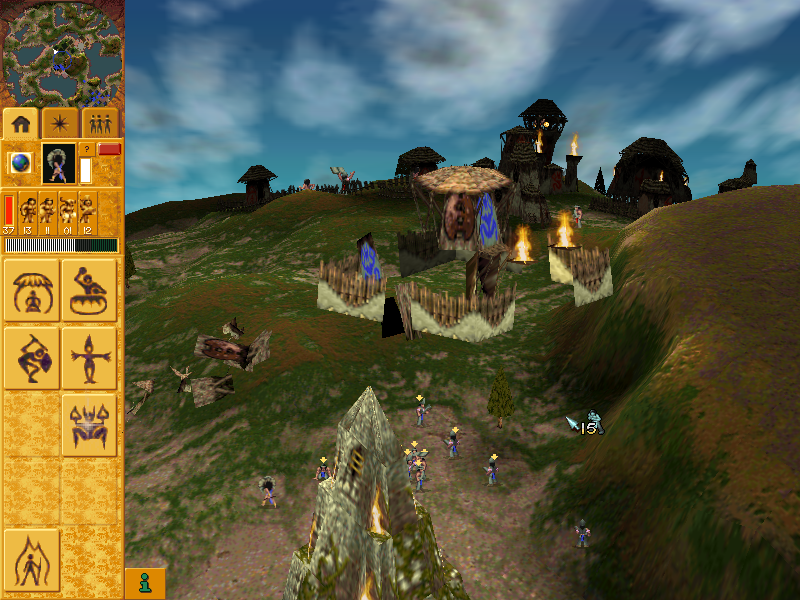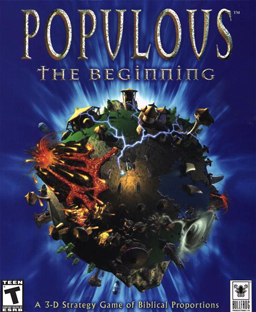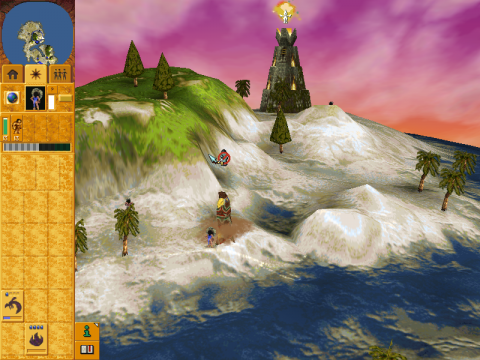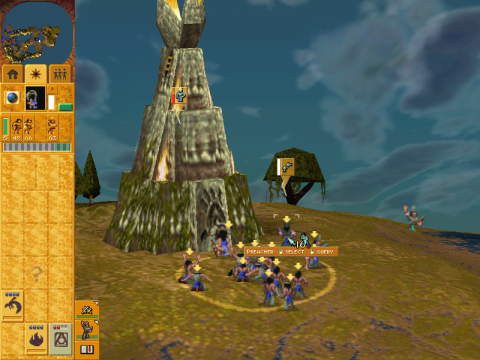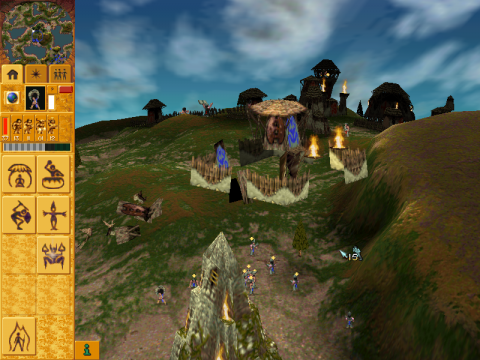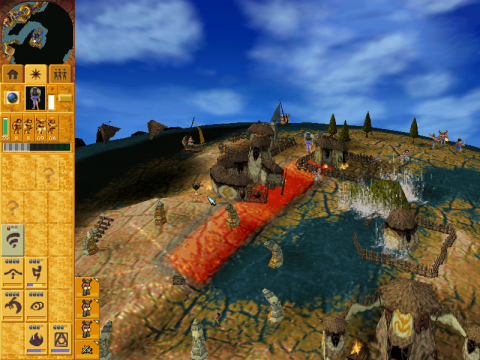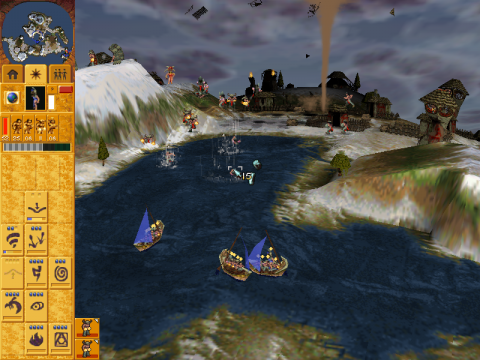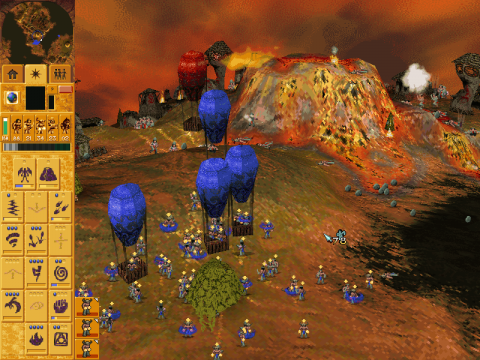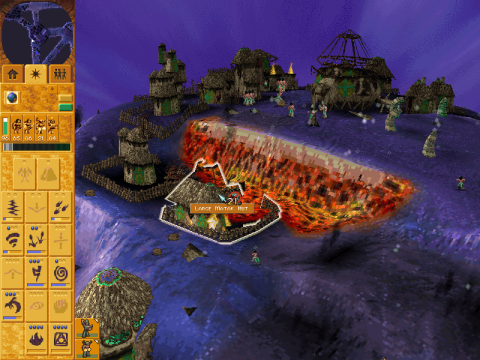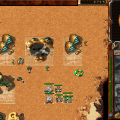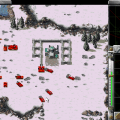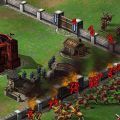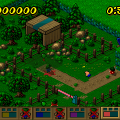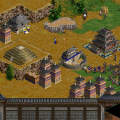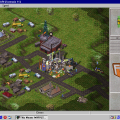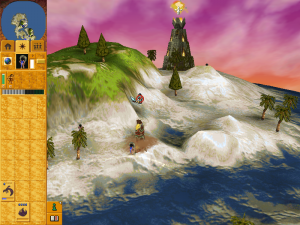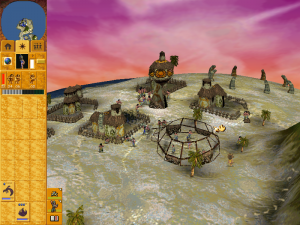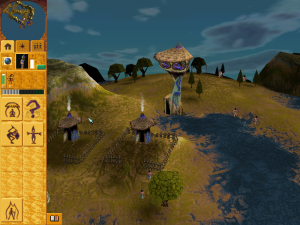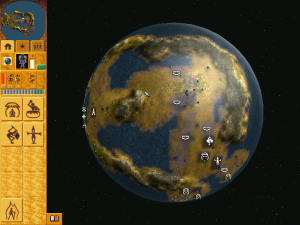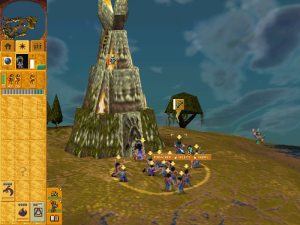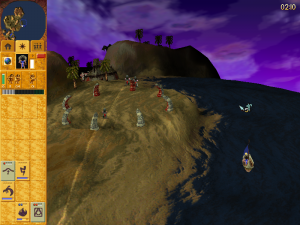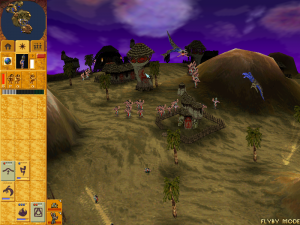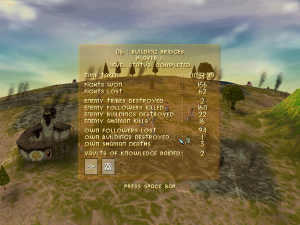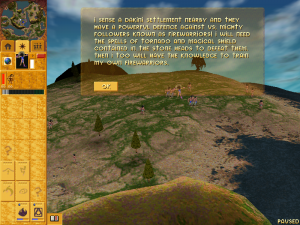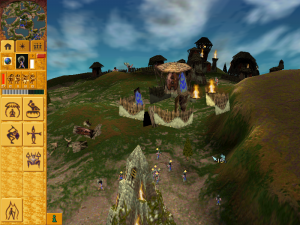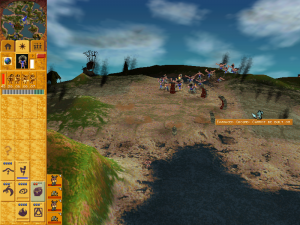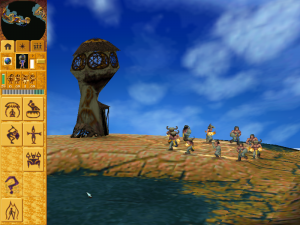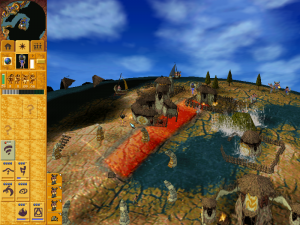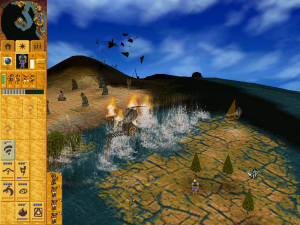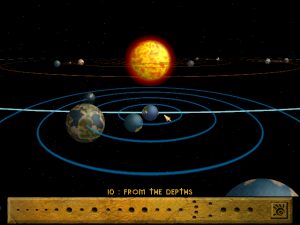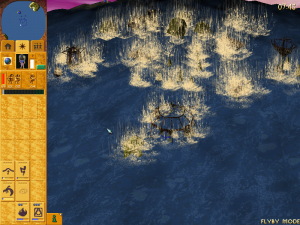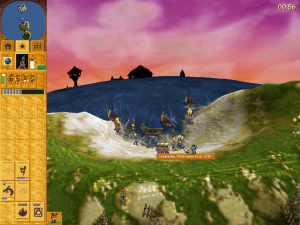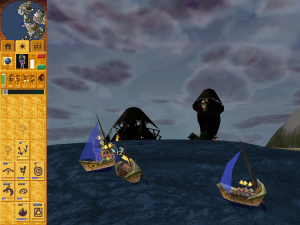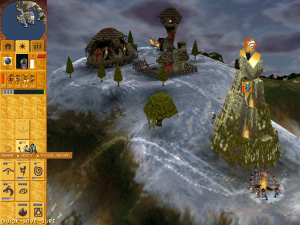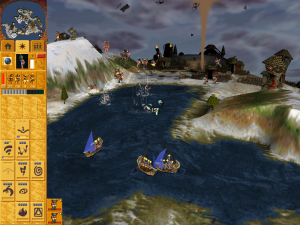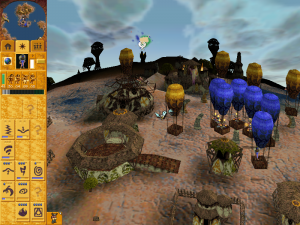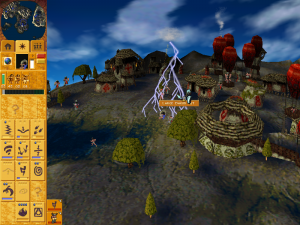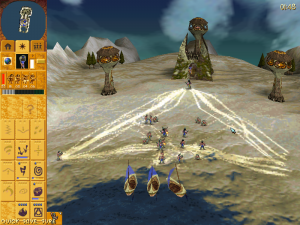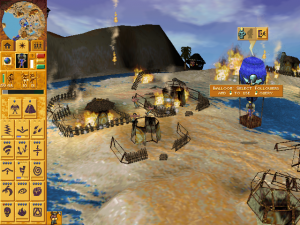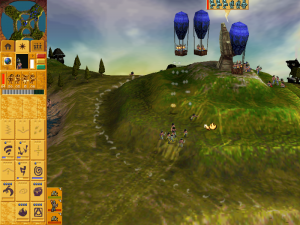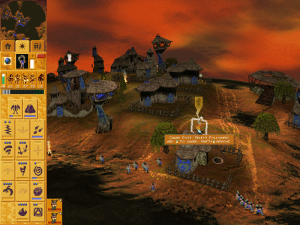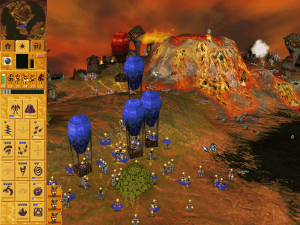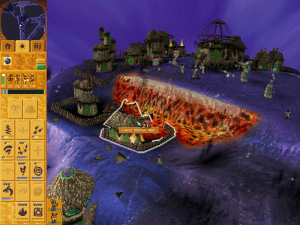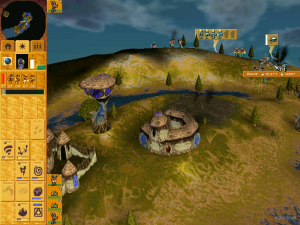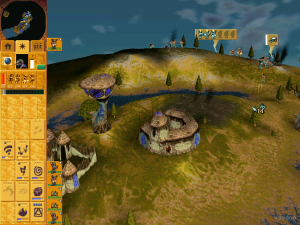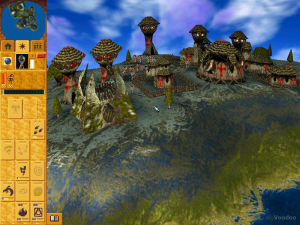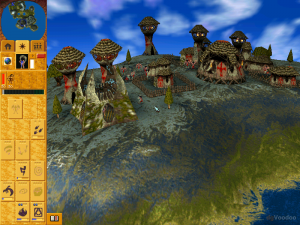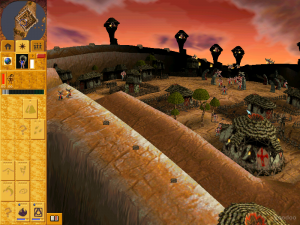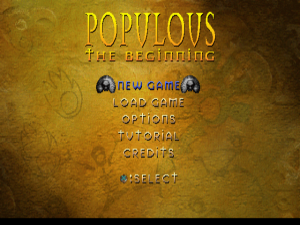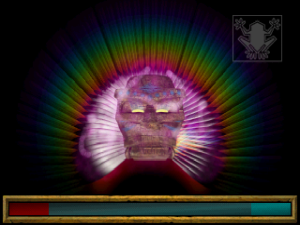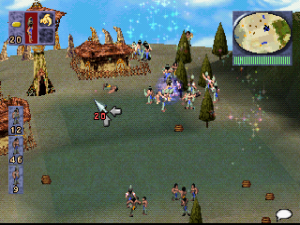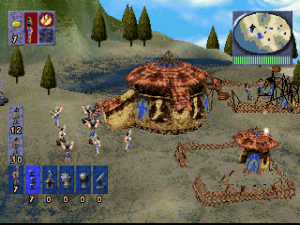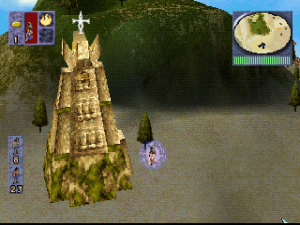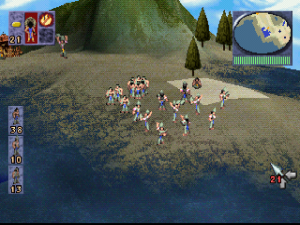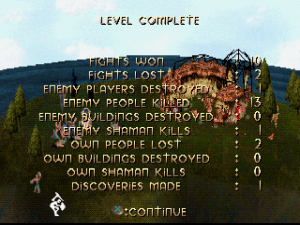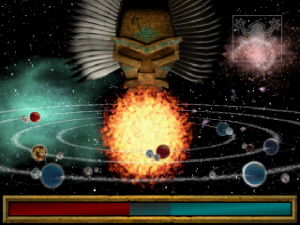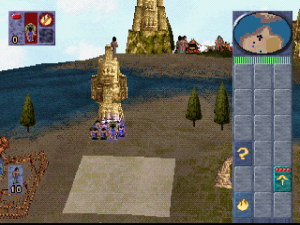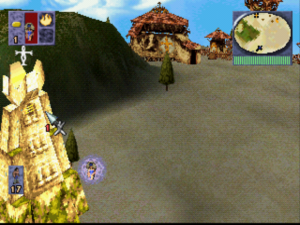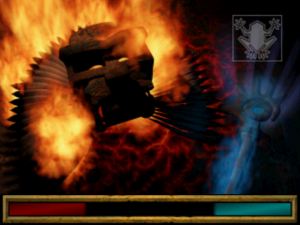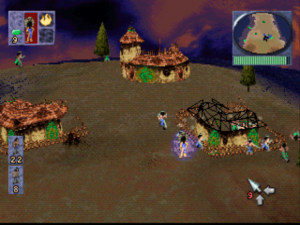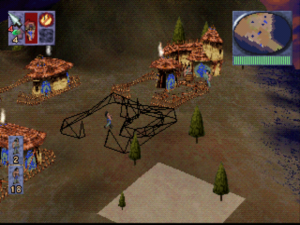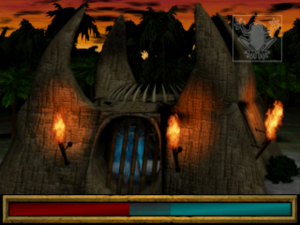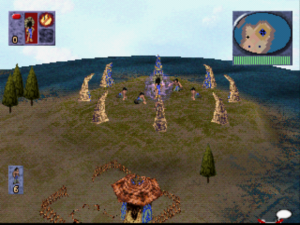- Populous
- Populous II
- Populous: The Beginning
- Populous DS
“I didn’t have time to look at games. I was walking in, spending half an hour with them, and then walking out. That was the worst period of my life. Bullfrog was everything to me, and suddenly I was this character that would have to walk into a room and make instant judgments about things.”
-Peter Molyneux, 2009 Gamespot interview
By 1994, Peter Molyneux had risen to the ranks of EA vice-president, and had seen Bullfrog Productions blossom into a sought-after partner to one of the largest publishers of the time. While Molyneux would later say that his new responsibilities overwhelmed him, the paycheck certainly did not—at least at first. Populous and its sequel had made Molyneux a star overnight and conferred upon his ragtag crew a respectable name in the industry. With titles like Magic Carpet and Syndicate garnering critical acclaim, Bullfrog proved that it was not a one-trick pony; these were also the golden years that made Mark Healey (Little Big Planet) and Demis Hassabis, whose work on A.I. would land him a $625 million dollar deal with Google.
But they were short-lived, as golden years tend to be. Molyneux’s time at the heights of corporate power would leave him unsatisfied, ultimately leading to his departure from EA in 1997, two years after Bullfrog’s acquisition by the very same. It was the development of the renowned Dungeon Keeper that would be his undoing: started after the release of Magic Carpet, the game dragged into a two-and-a-half year project and strained relations between the designer and the company. Molyneux’s apparent dissatisfaction with Dungeon Keeper’s similarity to Command & Conquer even lead to a complete re-write six weeks before deadline (unsurprisingly, Glenn Corpes tells a different version). The resulting game would prove to be another hit, and some would argue the best refinement (or derivative) of the god game formula until Dungeon Keeper 2. But the damage had already been done—Molyneux unceremoniously marched off to found another company which would bring him back to his roots as an intrepid designer, where he could work with a small team and “keep that tribe feeling”: Lionhead Studios.
For years, Molyneux claimed his departure was a matter of creative differences, but in his own modern re-telling, a drunken e-mail was the source of the whole mess. As the years wear on, sorting fact from fiction has become a kind of magical realist paradox with this Very Prodigal Son of Gaming—especially as more and more stories seem to involve the wild and wacky effects of alcohol. Regardless, it is clear that the spirit of Molyneux’s move was spurred by the poetic, if undisciplined idealism he would come to be known for in the coming years: a desire he would repeatedly express, much to the frustration of his peers, to descend from the jet-setting world of big business to the everyday nuts and bolts of game design.
This conviction would change the direction of the new Populous, the first in the series to set sail without the paternal guiding hand of its biggest advocate and founding (co-) creator. By release, its original subtitle, The Third Order, would be quietly changed to The Beginning, telling of the kind of reboot Bullfrog had in mind. And shocking as it was for Molyneux to leave the very company he founded, critics and industry experts worried less about his career—this was Peter Molyneux, after all!—and more about Bullfrog’s ability to stand on its own without its most magnetic spokesman. “Not only does Bullfrog need to prove that there is life after Molyneux,” wrote Edge magazine in Christmas 1998 (p. 92). “There’s also the tricky task of doing justice to Populous without going back over old ground. Many other development teams would crumble under such pressure”.
The World
“This isn’t a Populous for the 3D-accelerator age; it’s a game that takes inspiration from the original, but little else. ” Ron Dulin, 1998 Gamespot review
Populous: The Beginning is supposed to be set chronologically ‘before’ the original games, perhaps to explain why players have downgraded to manipulating measly corporeal bodies instead of the mighty clay of the world itself three games in. But in so doing the team at Bullfrog doubled down on the original game’s one-dimensional ‘primitive’ theme, this time rendered with enough attention to detail to upgrade the story from misguided to unctuous. Set in the apparently bacchanalian, totem-worshipping times of fore-history, the player’s ‘Shaman’ is on a nobly savage quest to become a god by annihilating all heathen tribes, a sophomoric premise about magical Indians which pervades every inch of the game world in groan-worthy detail.
But on the highest settings, The Beginning is still compelling despite its age, popping with (questionable) personality. Bullfrog pulled no punches with this effort, and it shows: a smooth-rolling, curved-perspective globe takes advantage of the contemporary prowess of Direct3D (built on a souped-up Magic Carpet engine), special powers rip up and warp the landscape in never-before-seen detail, and a handful of highly-produced New Age tracks—peppered liberally with random wails and distant war-whoops—coo ominously to wind-swept wooden flutes throughout. Perhaps Bullfrog felt it was necessary to make a good first impression, as the game itself would throw longtime fans for a loop.
Whereas Populous had made a name on its disarming indirection, The Beginning defies series tradition by forking control over to the player in almost every respect. The core gameplay is still there: grow your community, transform the map to your advantage, and destroy everyone else—but this time, players are granted direct control of individual units, buildings, and spells. No longer do players watch their mad creation unfold like excitable but impersonal Prime Movers, they are physically incarnated on the map as the aforementioned Shaman through which all miracles are cast. And while the land does indeed bend to players’ whims, it does so far less frequently, and for more specifically than ever before. Indeed, if Populous wasn’t in the title, fans could be forgiven that thinking this description fits an entirely different series of games, for in truth The Beginning is an RTS through-and-through.
Gone is the open-ended slog of randomly generated maps; in Populous: The Beginning, each level is instead a very manic sort of puzzle. Taking direction not from its direct predecessors but from The Challenge Games (the lesser-known expansion for Populous II), players must divine their way through 25 levels in a single player campaign. Maps range from huge free-for-alls over sprawling archipelagos to small, lonely islands with a single target, in the usual range of warm to freezing climates. Artifacts litter this landscape, culled willy-nilly from world cultures and transmogrified into uncanny inverted images of themselves: Easter Island-style Moais bob their heads like windshield accessories, and vaguely Mayan ‘Vaults of Knowledge’ shimmer with cosmic energy. The former, when worshiped, provide one-off powers that run out after a few charges, while the latter tend to provide a permanent ability or a new building type. There are also Totem Poles and Obelisks – rounding out the game’s hemispheric heist job – which help transform the landscape and give extra spell charges respectively.
Each level will start with the player’s Shaman forging a stone circle around herself—her ‘Reincarnation site’—as she is worshiped by her ‘Braves’ (a name quite explicitly plucked from the imagery of the American frontier). This will serve as her holy spawn point for the rest of the game; just as shamans are incarnated divinity, so can they die. This ultimately makes much of the game a delicate balance between sending her out for magical drive-bys and keeping her within the pale of safety. Initially, players will be facing off with one other tribe (the ‘Dakini’), then two (the ‘Chumara’), and three at a maximum (the ‘Matak’). ‘Wildmen’, a band of grunting nomads content with simply munching on trees, will run around aimlessly until brought under the protective wing of one or another tribe—a crucial early boost and perhaps a curative to the notoriously plodding build-up phase of early Populous.
At the start, players will find themselves quite limited, with access to only a single building: the hut. But as Populous fans should know, this humble abode is the foundation of the god-game formula, at least as Bullfrog would have it. Players gain ‘Mana’ from the amount of followers they have, and so it is in their interests to immediately begin building as many dwellings as possible to expand. Buildings are planted as in any RTS, by laying the blueprint on the landscape and seeing if it fits—but only next to another, existing structure or the specially-zoned Guard Towers, which can be built anywhere. The Beginning also offers ports for making boats, hot air balloon factories (yes, this game has hot air balloons), and a whole range of training grounds for new offensive units.
These units range from the simple, such as Warriors and Fire Warriors (particularly deadly in Guard Towers or in balloons) to Preachers, who can arrest enemy followers in their tracks with their (decidedly Christian-looking) sermons. What’s more, if they preach for long enough, enemy followers will even switch sides, making penetration into enemy territory exponentially deadlier with theologians in tow (a rare touch of realism in what is otherwise a narrative desert). Later in the campaign, players also gain access to the feeble but pyromaniacal Spies, who can infiltrate enemy bases and silently light buildings or trees on fire. The whole game consists of these five units, and yet the interplay between them obviates the need for any more.
On their own they may be fairly limited—but with each successive vehicle, and each successive spell, players are forced to revisit this straightforward quintet and continually devise new ways of deploying them. With powerful shielding magic or sailing together en masse in an ahistorical armada, even the most vulnerable units can become a deadly ace in the hole, and there are enough unique restrictions on each of the maps to let each unit have its time to shine. Sailing and flying in particular open up this Populous to a whole new plane of play, literally and figuratively: vehicles vastly increase the speed with which units can move around the map and contribute beautifully to the organised chaos players are expected to manage, far greater than in any previous Populous.
Amidst this mayhem, players will find themselves locked in combat between Shamans, the closest thing Populous: The Beginning has to the classic ‘knight’ of Populous yore. Players can no longer mindlessly order this power-unit away while they focus on other tasks—rather, they must carefully escort her around the map to avoid being sniped, for she gifts a boost of soul energy (used for charging spells) to her opponent upon death. And as there is no longer a global Mana pool but specific charges for each and every spell, her arsenal must be curated from moment to moment according to the whims of battle. She is, in the words of Rock Paper Shotgun’s Oliver Milne, almost a “MOBA character avant la lettre”, once again reinforcing the sense that this Populous is genetically closer to Warcraft III than any of its own kin.
At this point, the usual landscaping powers which may ground lost and panicking Populous fans offer no respite either. They have been whittled down to a sleek triptych: Land Bridge, Erode, and Flatten. Land Bridge connects two points across a strait of water, while Erode sinks terrain and can chuck buildings into the sea if used correctly; as for Flatten, it adjusts all land at its cast-point to the same height, useful for building in extremely hilly areas. With little offensive application, terraforming spells are usually best saved for precise moments, such as a backdoor invasion across a mythical Bering strait, or settling in unlikely locales. All this means that the frantic, non-stop clicking that made Populous a nerve-wracking exercise in advanced hand injuries is all but gone in The Beginning. Players could easily find themselves going most or all of a level without using these powers at all.
As for her offensive spells, the most basic—and most frequently used—is the ‘Blast’ spell, which can send targets flying outwards or even into the sea (making drowning much more viable and, morbidly, fun in this Populous). It is indispensable in saving the physically weak Shaman from direct melee attacks and even for boosting units onto higher planes, introducing a mechanic absent from many of its RTS brethren: gravity, which all higher-tier players must master to win. Next up is ‘Lightning’, a powerful equaliser which can set buildings (and trees) on fire, ‘Swarm’ (which sends down a band of locusts and causes enemy units to run in terror), and ‘Convert’ (which dyes Wildmen in its caster’s colors).
Then there are the power spells, which come in two tiers: the feasible and the extremely rare. As for the first set, we have ‘Tornado’, ‘Swamp’ and ‘Earthquake’. Tornado can be used to rip apart buildings, eject units from guard towers, or even move one’s own units out of danger (with practice). Earthquakes crush buildings to pieces and cause them to sink into the sea, and are most effective in coastal regions where the water can easily rise. And swamps function identically to their predecessors and cause instant death upon contact (a camper’s dream).
But it is the second tier that is more worthy of the old-school religious cataclysms it parodies. ‘Firestorm’ can destroy up to four buildings and any unit that wanders into its path. ‘Angel of Death’ spawns a strange dragon-like beast which flies around eating units out of towers. And in the most visually striking and sadistically joyful of all of The Beginning’s spells, there is ‘Volcano’, which almost justifies the series’ passage into 3D on its merit alone. Casting it causes the landscape to rumble and creak upon casting, giving players a scant few seconds to run to safety before a huge, red-hot geyser bursts through the ground, exploding and finally burning anything in its path. It is, along with Earthquake, the most visually satisfying of the power spells. Spells such as ‘Invisibility’, ‘Hypnotise’, and the nearly-overpowered ‘Magical Shield’ (often turned off in multiplayer games), provide even more mischievous potential, proving to be far more versatile and responsive than much of the fluff used to beef up Populous II’s divine catalogue.
What’s more, each of these spells has finer points of use and indeed even finer properties that are only discovered with extensive play. Volcanoes, quite logically, form islands of rock around them in the middle of an ocean, and can bridge two islands together, while a Tornado will leave behind the building materials from what it destroys, meaning the wood can be reused for other purposes. Even the Blast spell has a different effect depending on whether players fire at a unit itself or in front of its feet; on this subtle difference alone there has been much said in the community. Experimenting with these effects on one’s opponents—who roar in terror as they die in darkly comic pseudo-Wilhelm screams—is the heart and soul of Populous, and it has never been more richly realised than in The Beginning.
This technical wonder can be short-lived, however, when units simply don’t respond to being clicked. Noted by many contemporary reviewers for being clunky and frustrating even by the nascent standards of the day, playing The Beginning today requires a bit of patience. Idiosyncrasies of movement and pathfinding deflate the game’s momentum, as the game state changes rapidly and units simply won’t do what they are asked. Familiarity with the game’s shortcuts, as well as the HUD’s less obvious intricacies, do alleviate these concerns somewhat, but not enough to make it feel anything other than dated by today’s slicker RTS standards. As such, saving frequently is a must for all but those attempting to “Ironman” through the single player campaign—not so, of course, in multiplayer, where one misstep can spell the game.
In early 2017 Rock, Paper, Shotgun ran a story on The Beginning’s “superfans” who were still playing the game 18 years later. It is a brief but bittersweet portrait of a story familiar to many games with online support, which eventually wanes and ultimately dies unless cradled in the loving hands of its community. In The Beginning’s case, the game has been more than cradled: it has been nurtured, groomed and matured to nearly-burnt out adulthood in obscurity. And if the original Populous became an ‘electric delight’ in the company of others, then The Beginning becomes a bass-thumping glowstick rave—the skill-level is high, the speed of play is breakneck, and the permutations of maps, modes, and match-ups are endless enough for the party to go on forever.
Aided by the fan-made Populous MatchMaker tool available on the Populous: Reincarnation website, players can choose from hundreds of maps, change which kinds of units and spells are allowed, and just about everything else. And multiplayer Beginning is no joke: all of the skills necessary to triumph over its punishing single player mode are a mere prelude to the game’s true competitive depth. Players in high-level matches can be seen constantly building, dismantling, and re-building their huts to take advantage of the immediate extra Brave awarded upon their completion, saving their Shaman from certain death with a last minute land-bridge before hitting the water, or even by shooting Fireballs while still in the eye of a tornado. This is not to mention new multiplayer ‘Guest Spells’ such as the ominously-named ‘Bloodlust’ and ‘Ghost Army’, which add to the learning curve and the high barrier of entry to this Elo-ranked community. Even still, no one should give The Beginning a go without at least trying some online match-ups or playing with friends, because a human opponent will still outwit this game’s dated A.I. any day of the week.
Versions & Expansions
“It’s not that Populous: The Beginning is a bad game, it’s just a bad PlayStation game.” Jeff Gerstmann, Gamespot Review
Not much needs to be said about the PlayStation port of The Beginning. It is a demonstrably inferior version of the game, most obviously since players are forced to meticulously comb the landscape with a combination of analog sticks and the D-pad instead of a mouse. Selecting units is a chore and the game lags unforgivably with more than a handful of units on the screen. Other features effectively dumb down the game to an unrecognisable point: Priests convert far faster, Braves multiply at a ridiculous rate, and the Blast spell is now unlimited, making most levels very easy to clear on the first try. Add to this an overwrought, baroque narrator who comments on almost every major action in the game and it is not a pretty picture. Speaking of pictures, the graphics have been distilled to the crunchy, serrated triangles that made the PlayStation famous, and they don’t look very good. This port appears to be a standard cash-in, preying on unsuspecting consumers unaware that it is barely playable.
Populous: The Beginning: Undiscovered Worlds was released in early 1999 to little fanfare, being listed simply as a ‘data disk’ for the original game in many magazines. The expansion is a welcome addition to the limited single-player campaign, with twelve levels that introduce enough twists to keep things interesting and even more challenging. Several levels feature a receding landscape either via lava or rising tides, and some seem to have been born of random thought-experiments in design-by-negation, such as maps that strip player powers entirely—to be regained Totem by Totem—or having both Shamans locked in cages until they are freed. Undiscovered Worlds also features 12 new multiplayer maps, some of which continue to be popular in contemporary match-ups of The Beginning.
Reactions to Undiscovered Worlds varied considerably. PC Zone lauded the ‘divine inspiration’ which touched the expansion, while PC Game World questioned if it would appeal to anyone other than the already converted. With the benefit of hindsight, the latter rings truer; it is a fine addition for anyone craving more of The Beginning, but almost entirely forgotten otherwise. Modern-day editions such as the one available on GOG.com usually come with Undiscovered Worlds packaged in, so modern players will likely never have a chance to know if they’d even miss it.
Verdict
“Mystics. Shamen [sic]. Obelisks. Reincarnation. Magical energy. It sounds like the stuff of a mid-seventies concept album, one of those preposterous ‘rock operas’ excreted by overpaid acid casualties with too much time on their hands.” PC Zone, Issue 70, December 1998
“Agents of colonialism…often display nostalgia for the colonized culture as it was ‘traditionally’ (that is, when they first encountered it). The peculiarity of their yearning, of course, is that agents of colonialism long for the very forms of life they intentionally altered or destroyed.” Renato Rosaldo, Imperialist Nostalgia
However it strays from the core formula, and however obtuse its controls, there is in The Beginning that endlessly-refined genetic breeding shared across almost every Bullfrog title: that simulation DNA which brings out the unethical scientist in us all, probing and ultimately smashing our ant colonies over and over again, just to see the little creatures squirm. The Beginning does a very good job of rigging a slow-drip that steadily introduces these little sadisms, with a steep difficulty curve towards its latter half that makes for an extremely challenging end-game.
Its somewhat mixed reception by major magazines is puzzling at first, as complaints of repetitiveness and shallow gameplay appear exaggerated. In context, however, there is some sense in The Beginning’s mediocre reception: it had the misfortune of being released in the same month as Half-Life, after all, whose single-player campaign represented a quantum leap in game storytelling. And for all of its bravado in striking out from the core formula, The Beginning had really sought to meekly reunify with a new emerging mainstream in an uncertain time for Bullfrog. The intervening years between Populous II and The Beginning had seen not only many ‘god sim’ imitators, but the burgeoning RTS genre itself, with which Populous shares many evolutionary traits. By March 1999, Computer Gaming World was already writing that the RTS was a “stagnating genre” (Vol 176, p. 189), so this decidedly ‘RTS-like’ Populous was therefore measured against some heavy-weight contenders to the throne. For a company whose reputation had been built on genre-defying stunts of artistry, anything less than a revolution in design—especially after such a long hiatus—may have felt like a letdown.
But upon further inspection, it is actually The Beginning’s austere mechanics which separate it from its competitors. For Populous has never been simply about armies facing off against each other, but a world which is teeming with life and responsive to the player’s actions. In this sense, the game’s minimalism gives space for the series’ one true constant: the land itself. And even here, in this strangest and Molyneux-less of entries, it remains key. Although players may not be actively shaping it at all times, the physics of getting around it and over it feature much more prominently here than in any game where all the action happens on locked planes of movement. And where most genre titles boil down to a kind of rapid-fire number-crunching, The Beginning shares with platformers those heart-stopping, finger-crossing dives and parabolas that can mean the difference between a safe landing and a dead drop into a game over.
In all of this, The Beginning displays the best qualities of a spiritual successor: it does not sheepishly hearken back to the tried-and-true mechanics of its forebear at every opportunity, but instead boldly refashions them in creative and unexpected ways. What’s more, The Beginning remains vital and full of personality in a way that many contemporary RTSes lack. It is rather unfortunate, then, that this personality ends at the brute mechanical level and nose dives when it comes to its theme, which has about the depth & authenticity of Iron Eyes Cody.
The ludicrous assumptions that go with this style of ‘tribal’ world-building, compiled by the world’s techno-fortunate, are almost too many to enumerate. That Shamans are of Siberian origin and not the Meso-American/Polynesian mish-mash from which The Beginning clearly draws its inspiration is apparently of little importance, as are the implications of having characters mumble in a nonsensical, vaguely non-European sounding language with every click. One imagines a fictional European tribe which drew elements from the chronologically (and culturally) out-of-sync “vikings” and Western Roman Empire arousing great ire from the gaming public, while paper-thin storyboards like this one routinely pass inspection. And rather than receiving any sanction for being ridiculous or offensive, the game’s atmosphere has repeatedly drawn praise, and is often one of the high points cited by fans who give themselves tribal monikers and mystical-sounding clan names as they shout racial slurs at each other over voice chat.
Not that this is necessarily new. From playground games of ‘Cowboys and Indians’ to Avatar, the mythology of indigenous savagery and innocence has served as a backdrop for many stories in the Western imaginary. Shari M. Huhndorf, in her book Going Native: Indians in the American Cultural Imagination, writes of the use and abuse of the Indian as a metaphor and foil to civilized life, and she demonstrates how the romantic power of native cultures tends to increase precisely as they have been taken over. That is to say, the further Native peoples have receded in physical and political space, the more present they have become in the consciousness of the dominant culture, often as representatives of a kind of magical ‘pre-history’ to the colonisers themselves, even when such communities persist and thrive to this day across the ‘fourth world’.
The Beginning is no exception. If it isn’t already obvious, the childish bluntness of this war of all against all is nothing new in the centuries-old practice of ‘going native’, on any of the continents the game uses for its inspiration. And in an era where geeks have been up in arms over the possibility of a black Thor, it is not difficult to understand why The Beginning hasn’t faced similar scrutiny—it is quite simply a double standard. This is all the more frustrating as the game’s 3D world is so much more lush than its predecessors and so rich with real mischievous, cartoonish potential.
Ultimately, fiction is always fantasy, and so the charge that it is ‘inaccurate’ can always be parried with the defense that accuracy isn’t the point. But in a game as stylistically muddled as The Beginning, it is actually more elemental than that: what is at stake is not accuracy, but premise. Stories of this stripe are a kind of séance, a temporary communion with taboo that can be safely shed like a second skin at their conclusion, a fact which finds echoes in everything from the booming Ayahuasca ‘vision quest’ industry to the names of notorious sports teams and their unironically morbid chants. They are about re-enacting a long line of Boy Scout rituals, ‘Frontier’ exhibitions, and even holidays that keep the imagined opposite of settler society alive and well in the realm of the imagination, but absent in life itself. As Huhndorf has written, if “men and boys regenerated themselves by fighting Indians, apparently they thrived by playing Indian as well.” (p.66)
This also raises the question: if gaming—which promises a kind of godhood writ-large in superhuman, impossible virtual realities—leads to a form of abstract Schadenfreude and toys with the lengths of player sadism, then where does that line stop? When does it get too uncanny, too real? Mocking the bureaucracies that surround us, as in Theme Park or Theme Hospital, or even the sanguine morality plays of folklore as in Dungeon Keeper, saw Bullfrog at least trying to follow in the footsteps of the best traditions of dark, cynical satire for which their native country is renowned. But mocking people is very different from mocking systems: in this case irony is no longer “militant”, in Northrop Frye’s rendering, but lazy. And in The Beginning, the satire is indirect: for the joke is on us, and on Bullfrog, for giving it a seal of approval. That it is a fine game in spite of these narrative blunders is less telling of Bullfrog in particular and more of the games industry as a whole.
At the end of the day, The Beginning deserves a playthrough as a unique RTS of its time, and especially for fans of Populous who are willing to accept its diversion from the series foundations. But it also deserves to be superseded by future generations of game-makers—inspired by Bullfrog’s (in)famous big picture-thinking—who know they can do better.
Links:
On Populous: The Beginning:
CD Mag Preview for The Beginning
Gamespot Preview for The Beginning
Gamespot Review for The Beginning
PC Zone Review for The Beginning
NOW Gamer Review for The Beginning‘s PSX port
Gamespot Review for The Beginning‘s PSX port
PC Game World Review for Undiscovered Worlds
Meet the Superfans Still Playing Populous: The Beginning – Rock Paper Shotgun piece that serves as a good “human interest” story
Community Resources:
Populous: Reincarnated – Unofficial hub for all things Beginning
Populous Wiki – Run by Populous: Reincarnated
Populous: Resurrection – A split from Populous: Reincarnated which hosts a rival matchmaker client
Populous: Tribal Conquest – A defunct fan expansion/sequel for the game
The Beginning YouTube Channel – Contains a fan-made trailer. In addition, the user running this channel, Sub, is recruiting fans and players to become part of an interactive single-player campaign in which contributors to his Patreon can take the role of the enemy A.I., turning the base game into a new kind of community challenge. A great example of the community keeping itself relevant.
On Bullfrog & Molyneux:
Bullfrog ‘stopped being the same’ after EA takeover – 2016 piece with several former employees discussing the transition period
The Secret History of Lionhead – A good primer on the transition period between Populous II and Molyneux’s future titles
2009 Gamespot Retrospective on Molyneux’s career – Lots of fascinating tidbits in here that speak to many of the themes in this series
IGN Interview with Peter Molyneux – In which he claims a drunken e-mail led to his departure from Bullfrog
On Native America and Stereotypes:
TV Tropes – Magical Native American
Women in Indian Captivity Narratives
Sheri M. Huhndorf, Going Native: Indians in the American Cultural Imagination
